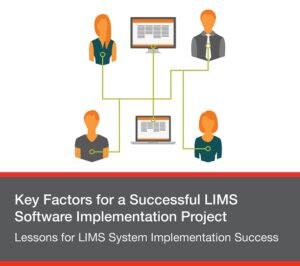Lessons for LIMS System Implementation Success
 We are often asked by new or prospective customers, “What are the factors to ensure a successful implementation project?” Our experience within the LIMS software industry has allowed us to work with many different clients and has taught us the ingredients of what makes a successful implementation project. We have had the privilege of working with over one hundred clients ranging in size from twelve employees to tens of thousands. We’ve gained experience in diverse industries from biopharma and crop science to manufacturing and food & beverage. No matter the size of your company or industry you reside in, we believe that we have found three common best practices to ensure success – read on to find out more…
We are often asked by new or prospective customers, “What are the factors to ensure a successful implementation project?” Our experience within the LIMS software industry has allowed us to work with many different clients and has taught us the ingredients of what makes a successful implementation project. We have had the privilege of working with over one hundred clients ranging in size from twelve employees to tens of thousands. We’ve gained experience in diverse industries from biopharma and crop science to manufacturing and food & beverage. No matter the size of your company or industry you reside in, we believe that we have found three common best practices to ensure success – read on to find out more…
Best Practice for LIMS System Implementation Success #1: Full and Regular Communication
Full Communication Eases LIMS System Requirements Definition
This sounds obvious, but communication can be overlooked. Oftentimes, customers will assign one point person to discuss system requirements with our team. A primary, consistent contact and decision maker is important to keep the project on track, however, we have found that active participation from a broader group of end users and subject matter experts (SMEs) can provide valuable context and help the LIMS provider to understand the customer’s specific requirements.
For example, we have found that developing a requirements gathering agenda including the areas of focus for each meeting can help get the right attendees in the room – while still being sensitive to your employees’ time commitments. Overall, encouraging involvement from a larger team is critical to promote quick adoption, especially if your company is implementing technical software such as our LIMS system.
Regular Communication Improves LIMS System Requirements Acceptance & Timeline Achievement
Active communication should not stop after the requirements specification is approved. Configuring the solution should be equally collaborative. In our delivery model, end users are engaged regularly (at a minimum every 2-3 weeks) to see demonstrations of the in-progress configurations. This allows for a more robust design, as requirements can change once the customer sees the actual solution. We also provide access to the configuration environment and encourage our customers to test out the functionality after every demonstration. You shouldn’t wait until the end of the configuration phase to see the solution and then start requesting changes. By collaborating closely throughout the implementation, time to complete User Acceptance Testing (UAT) is decreased and end-user adoption is expedited.
Best Practice for LIMS System Implementation Success #2: The small details can have a big impact.
A Zebra printer costs about $200 and can be configured in an hour. Nothing is more disappointing than getting to the end of an implementation project and realizing the lab needs to purchase new hardware – especially if the internal purchase order (PO) process will cause a delay.
Every implementation project starts with a focus on the user requirements and understanding of the operation’s workflows. Accessory hardware needs to be a part of that early discussion. For example, we include a series of technical requirements discussions in parallel to the user requirements discussions when we are working with clients to implement our laboratory information management systems. This ensures enough lead time during the entire process in case new accessory hardware is needed and avoids delaying the go-live date for something as small as a printer. We understand that details (and not just around hardware!) can make all the difference, and team with our customers to define and execute well thought out implementation plans so that you can be up and running on schedule.
Best Practice for LIMS System Implementation Success #3: Alignment on deployment processes.
We have a team of experienced and skilled project managers. The project managers develop a project plan around our activities (requirements, configuration, testing), and work with your project manager to ensure your goals and internal processes are also represented.
For example, each customer has their own unique internal release management and change control approval processes. Much of the work can (and should) be done in parallel to our configuration work and not impact the overall project plans. The same is true for other deployment activities such as: writing a SOP (Standard Operation Procedure) for end-users, to ensuing a full backup and disaster recovery process if you host on-premises. Project managers will work with your team to make sure that your unique processes and timelines are accounted for in our plans. The project managers prepare a deployment plan and checklist for each project, that we start reviewing with you ahead of UAT, to allow for a smooth production roll-out.
Want to Know More About How We Deliver LIMS Systems to Customers?
Our previous blog on Measuring Professional Services Time to Value summarized our metrics with respect to project budget, delivery timelines and overall customer satisfaction ratings. Many of those metrics enable us to maintain focus on the three best practices described above. We will follow this blog with a series that describes each best practice in more detail. We’ve found these elements are important for successful engagements and we are constantly working to improve. We invite you to share your thoughts and best practices, and look forward to hearing from you.




Leave a Reply